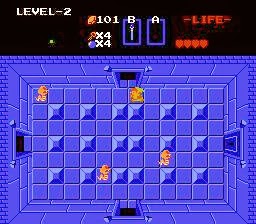The Birth of a Legend
A game routinely near the top of most greatest games ever or most influential games ever lists, The Legend of Zelda laid the groundwork that many developers would build up from and be inspired by. There's no doubt in many game enthusiasts' and historians' minds that The Legend of Zelda was a game that was clearly way ahead of its time. While that's without question true, how does Link's first ever quest fare today?
The evil Ganon has used his powers to lay siege to the once peaceful kingdom of Hyrule. In the process, he's captured Princess Zelda and locked her away in his Death Mountain dungeon. Players assume the role of the heroic green-clad Link, who must venture into eight dangerous dungeons in order to collect the shattered remnants of the Triforce of Wisdom. It is only then that he will be allowed passage into Ganon's lair, where hopefully he will save the Princess and Hyrule all in one fell swoop. Obviously such a tale is a touch simplistic for today's standards, but the premise was strong back then. Heck, it's still strong for many such as myself today.
The Legend of Zelda totally thrusts the player into an open world made up of individual screens. No direction is given to the player; no tutorials are to be found. There is but a cave on the screen where the player starts that practically just begs the player to enter it by just being there. Inside is a sword, and an old man stating one of the most referenced game quotes of all time, "It's dangerous to go alone. Take this." Even before entering the cave, the world of Hyrule has no gates or fences that block the player into freely exploring. Of course one probably wouldn't get very far with no sword, but it is possible to journey through Hyrule with nothing in Link's sheath.
 |
| To this day The Legend of Zelda series has yet to see as much freedom given to the player as the original. |
A lot of The Legend of Zelda's secrets are rather hard to find, and it doesn't help that clues given by the rare denizen of Hyrule (why they all live in caves is anyone's guess) are obtuse at best and mistranslated at worst. Seriously, how would one know to burn a specific bush to find a secret grotto, much more a dungeon that is required to make progress? Things like bombing a specific rock face on the world map, or burning a seemingly random bush for something now seems amazingly counter-intuitive. Regardless, if one has a serious sense of adventure, they will find it tough to come across many better games that puts that sense to good use than The Legend of Zelda.
 |
| Okay, well maybe a lone bush in the middle of a path is obvious... |
 |
| "Why did it have to be snakes?" |
 |
| These must be the ghosts of players who never beat The Legend of Zelda. |
Dungeons are the most dangerous locations in the game, each made up a labyrinth of rooms that are full of enemies. While foes like Ropes (snakes) and Keese (bats) aren't too problematic, things gets challenging when one has to take on a room packed with Darknuts, knights who can only be damaged from behind, and walk around totally at random. Each dungeon has locked doors that need keys to open them; hidden staircases uncovered by pushing a certain block in the room; special items like the Boomerang, the Raft, the Ladder, the Bow, etc. that assist Link on his journey; and a boss guarding a piece of the Triforce of Wisdom for Link to overcome.
 |
| A relatively harmless enemy in Zelda can still be a bit of a nuisance! |
A game terrific for those who want some difficulty in their action-adventure games, The Legend of Zelda still rises to the task to this day. However, many players today will find the original NES classic The Legend of Zelda too unrelenting in its challenge, not just against enemies but in order to make any kind of significant progress because of its lack of direction and sometimes obtuse design. This lack of any hand-holding certainly is a different feeling than present Zelda games and most other titles released in this day and age. Still, one cannot argue how influential the debut of Link really is to the industry, and how despite all of the issues with the game looking at it with a present-day lens, The Legend of Zelda still presents itself as a truly compelling and enjoyable game.
[SPC Says: 7.0/10]


